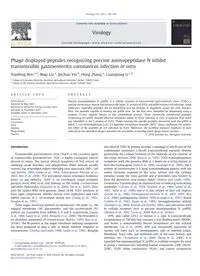
2011 Phage displayed peptides recognizing porcine aminopeptidase N inhibit transmissible gastroenteritis coronavirus inf PDF
Preview 2011 Phage displayed peptides recognizing porcine aminopeptidase N inhibit transmissible gastroenteritis coronavirus inf
Phage displayed peptides recognizing porcine aminopeptidase N inhibit transmissible gastroenteritis coronavirus infection in vitro Xiaofeng Ren a,⁎, Boqi Liu a, Jiechao Yin b, Heng Zhang a, Guangxing Li a,⁎ a College of Veterinary Medicine, Northeast Agricultural University, Harbin 150030, China b College of Life Sciences, Northeast Agricultural University, Harbin 150030, China a b s t r a c t a r t i c l e i n f o Article history: Received 26 May 2010 Returned to author for revision 22 June 2010 Accepted 16 November 2010 Available online 21 December 2010 Keywords: Coronavirus TGEV Peptides Phage display Vaccine Porcine aminopeptidase N (pAPN) is a cellular receptor of transmissible gastroenteritis virus (TGEV), a porcine coronavirus. Interaction between the spike (S) protein of TGEV and pAPN initiates cell infection. Small molecules, especially peptides are an expanding area for therapy or diagnostic assays for viral diseases. Here, the peptides capable of binding the pAPN were, for the first time, identified by biopanning using a random 12-mer peptide library to the immobilized protein. Three chemically synthesized peptides recognizing the pAPN showed effective inhibition ability to TGEV infection in vitro. A putative TxxF motif was identified in the S protein of TGEV. Phages bearing the specific peptides interacted with the pAPN in ELISA. 3-(4,5-dimethylthiazol-2-yl)-2,5-diphenyl tetrazolium bromide (MTT) assays confirmed the protec- tive effect of the peptides on cell infection by TGEV. Moreover, the excellent immune responses in mice induced by the identified phages provided the possibility to develop novel phage-based vaccines. © 2010 Elsevier Inc. All rights reserved. Introduction Transmissible gastroenteritis virus (TGEV) is the causative agent of transmissible gastroenteritis (TGE), a highly contagious enteric disease in swine. The typical clinical symptoms of TGE consist of vomiting, acute diarrhea, and dehydration. Older animals usually recover, but in newborn piglets mortality rates may reach 100% (Saif and Wesley, 1992; Laude et al., 1993; Schwegmann-Wessels et al., 2002; Ren et al., 2008). TGE prevalence causes enormous economic losses in pig industry. TGEV is an enveloped, single-stranded, positive-sense RNA virus that belongs to the family Coronaviridae and order Nidovirales (Enjuanes et al., 2000; Yin et al., 2010). They own the largest RNA viral genome, about 30 kb. TGEV produces at least eight subgenomic mRNAs during viral replication and each mRNA consists of 3′ co-terminal nested sets (Laude et al., 1993; Vaughn et al., 1995). Three major structural proteins of coronavirus: the spike (S), the integral membrane (M) glycoprotein, and the nucleocapsid (N) protein are translated from mRNAs 2, 5 and 6, respectively (Spaan et al., 1988; Laude et al., 1993; Almazán et al., 2000). The M protein is an abundant component of coronaviruses (Rottier, 1995; Ren et al., 2010b). The M protein as the major interferon inducing component has been proposed to play a role in innate immune response to coronaviruses (Charley and Laude, 1988; Laude et al., 1992). Roughly one-third of TGEV M protein assumes a topology in which part of the endodomain constitutes a fourth transmembrane segment, thereby positioning the carboxy terminus of the molecule on the exterior of the virion (Masters, 2006; Risco et al., 1995). TGEV N phosphoprotein complexes with the genomic RNA in a beads-on-a-string fashion to form the nucleocapsid (Suñé et al., 1990; Cavanagh et al., 1994). The S protein of coronaviruses is a large transmembrane protein with the amino terminus exposed to the virus surface and the carboxy terminus inside the virus particle and it assembles into trimers to form the distinctive viral surface spikes (Delmas and Laude, 1990). Coronavirus S protein plays an important role in inducing neutralizing antibodies (Garwes et al., 1978; Jiménez et al., 1986; Laude et al., 1987; Suñé et al., 1990) and it is also related to host cell tropism (Jacobs et al., 1986; Schwegmann-Wessels et al., 2003, 2009; Ren et al., 2006), pathogenicity (Siddell, 1995; Krempl et al., 1997), fusion (Collins et al., 1982; Spaan et al., 1988), hemagglutination activity (Krempl et al., 2000; Krempl and Herrler, 2001) and interaction with its cellular receptors such as porcine aminopeptidase N (pAPN) (Delmas et al., 1992; Liu et al., 2009; Ren et al., 2010a). APN, also called CD13 in human is a type II transmembrane ectopeptidase of 150 kDa that contains a zinc-binding motif (HEIAH) and forms a noncovalently bound homodimer on the cellular membrane (Liu et al., 2009). APN was extensively expressed on various cell lines such as hematopoietic cells of myeloid origin, fibroblasts, brain cells, and epithelial cells of the liver, kidney, and intestine, etc. (Tsukamoto et al., 2008; Zhang et al., 2008). It is reported that aminopeptidase N (pAPN) is a cellular receptor for most of group 1 coronaviruses including human coronavirus 229E (HCoV- 229E), TGEV, feline coronavirus (FCoV) and canine coronavirus Virology 410 (2011) 299–306 ⁎ Corresponding authors. Fax: +86 451 55103336. E-mail addresses:
